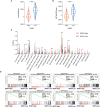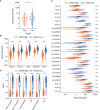An Immune-Related Gene Pair Index Predicts Clinical Response and Survival Outcome of Immune Checkpoint Inhibitors in Melanoma
- PMID: 35280982
- PMCID: PMC8907429
- DOI: 10.3389/fimmu.2022.839901
An Immune-Related Gene Pair Index Predicts Clinical Response and Survival Outcome of Immune Checkpoint Inhibitors in Melanoma
Abstract
The durable responses and favorable long-term outcomes are limited to a proportion of advanced melanoma patients treated with immune checkpoint inhibitors (ICI). Considering the critical role of antitumor immunity status in the regulation of ICI therapy responsiveness, we focused on the immune-related gene profiles and aimed to develop an individualized immune signature for predicting the benefit of ICI therapy. During the discovery phase, we integrated three published datasets of metastatic melanoma treated with anti-PD-1 (n = 120) and established an immune-related gene pair index (IRGPI) for patient classification. The IRGPI was constructed based on 31 immune-related gene pairs (IRGPs) consisting of 51 immune-related genes (IRGs). The ROC curve analysis was performed to evaluate the predictive accuracy of IRGPI with AUC = 0.854. Then, we retrospectively collected one anti-PD-1 therapy dataset of metastatic melanoma (n = 55) from Peking University Cancer Hospital (PUCH) and performed the whole-transcriptome RNA sequencing. Combined with another published dataset of metastatic melanoma received anti-CTLA-4 (VanAllen15; n = 42), we further validated the prediction accuracy of IRGPI for ICI therapy in two datasets (PUCH and VanAllen15) with AUCs of 0.737 and 0.767, respectively. Notably, the survival analyses revealed that higher IRGPI conferred poor survival outcomes in both the discovery and validation datasets. Moreover, correlation analyses of IRGPI with the immune cell infiltration and biological functions indicated that IRGPI may be an indicator of the immune status of the tumor microenvironment (TME). These findings demonstrated that IRGPI might serve as a novel marker for treating of melanoma with ICI, which needs to be validated in prospective clinical trials.
Keywords: immune checkpoint inhibitor (ICI); immune infiltration; immune-related gene pair index (IRGPI); melanoma; prediction.
Copyright © 2022 Yan, Wu, Yu, Kong and Cang.
Conflict of interest statement
The authors declare that the research was conducted in the absence of any commercial or financial relationships that could be construed as a potential conflict of interest.
Figures





Similar articles
-
Immune-related gene-based prognostic index for predicting survival and immunotherapy outcomes in colorectal carcinoma.Front Immunol. 2022 Dec 13;13:944286. doi: 10.3389/fimmu.2022.944286. eCollection 2022. Front Immunol. 2022. PMID: 36591255 Free PMC article.
-
An Immune-Related Gene Prognostic Index for Head and Neck Squamous Cell Carcinoma.Clin Cancer Res. 2021 Jan 1;27(1):330-341. doi: 10.1158/1078-0432.CCR-20-2166. Epub 2020 Oct 23. Clin Cancer Res. 2021. PMID: 33097495
-
Identification of a Novel Immune Landscape Signature for Predicting Prognosis and Response of Colon Cancer to Immunotherapy.Front Immunol. 2022 Apr 28;13:802665. doi: 10.3389/fimmu.2022.802665. eCollection 2022. Front Immunol. 2022. PMID: 35572595 Free PMC article.
-
Systematic review and meta-analysis efficacy and safety of immune checkpoint inhibitors in advanced melanoma patients with anti-PD-1 progression: a systematic review and meta-analysis.Clin Transl Oncol. 2021 Sep;23(9):1885-1904. doi: 10.1007/s12094-021-02598-6. Epub 2021 Apr 20. Clin Transl Oncol. 2021. PMID: 33877531
-
Combining BRAF/MEK Inhibitors with Immunotherapy in the Treatment of Metastatic Melanoma.Am J Clin Dermatol. 2021 May;22(3):301-314. doi: 10.1007/s40257-021-00593-9. Epub 2021 Mar 25. Am J Clin Dermatol. 2021. PMID: 33765322 Review.
Cited by
-
Integrative analysis of bulk and single-cell RNA-seq reveals the molecular characterization of the immune microenvironment and oxidative stress signature in melanoma.Heliyon. 2024 Mar 15;10(6):e28244. doi: 10.1016/j.heliyon.2024.e28244. eCollection 2024 Mar 30. Heliyon. 2024. PMID: 38560689 Free PMC article.
-
An immune-related gene prognostic index for predicting prognosis in patients with colorectal cancer.Front Immunol. 2023 Jul 6;14:1156488. doi: 10.3389/fimmu.2023.1156488. eCollection 2023. Front Immunol. 2023. PMID: 37483596 Free PMC article.
References
-
- Robert C, Ribas A, Schachter J, Arance A, Grob JJ, Mortier L, et al. . Pembrolizumab Versus Ipilimumab in Advanced Melanoma (KEYNOTE-006): Post-Hoc 5-Year Results From an Open-Label, Multicentre, Randomised, Controlled, Phase 3 Study. Lancet Oncol (2019) 20(9):1239–51. doi: 10.1016/S1470-2045(19)30388-2 - DOI - PubMed
Publication types
MeSH terms
Substances
LinkOut - more resources
Full Text Sources
Medical

